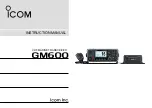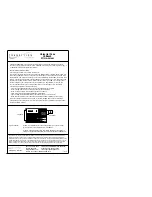
65-2396RK CO
2
Transmitter • 17
11. Turn on the controller and place it into normal operation.
NOTE:
When first powered up, the transmitter will enter about a one minute period when the 4-20
mA output is stabilizing and may be above the controller alarm points or well below zero
momentarily. RKI controllers have a one minute warmup period when the controller does not
display any gas reading or give any alarm indication. The CO
2
transmitter’s 4-20 mA signal
should be stable by the time the controller’s warmup period is over.
12. Allow the transmitter to warm-up for 5 minutes.
13. Calibrate the transmitter as described in “Calibration” on page 17 of this manual.
Calibration Frequency
Although there is no particular calibration frequency that is correct for all applications, a calibration
frequency of every 6 months is adequate for most infrared CO
2
transmitter applications. Unless
experience in a particular application dictates otherwise, RKI Instruments, Inc. recommends a
calibration frequency of every 6 months.
If an application is not very demanding, for example detection in a clean, temperature controlled
environment where calibration adjustments are minimal at calibration, then a calibration frequency of
every 9 to 12 months is adequate.
If an application is very demanding, for example if the environment is not well controlled, then more
frequent calibration than every 6 months may be necessary.
Calibration
This section describes how to calibrate the CO
2
transmitter. It includes procedures to prepare for
calibration, set the zero reading, set the response reading, and return to normal operation.
WARNING: The controller is not an active gas monitoring device during the calibration
procedure.
NOTE:
The following procedure assumes the use of a calibration kit which includes a calibration gas
cylinder, a 100% nitrogen cylinder, a 0.5 LPM fixed flow regulator with an on/off knob, a
calibration cup for the detector, and a short piece of sample tubing to connect the regulator to
the calibration cup.
Preparing for Calibration
1. Unscrew and remove the junction box cover.
2. Set a voltmeter to measure in the millivolt (mV) range.
3. Plug the voltmeter leads into the test points on the amplifier. Plug the positive lead into the red (+)
test point; plug the negative lead into the black (-) test point.





































